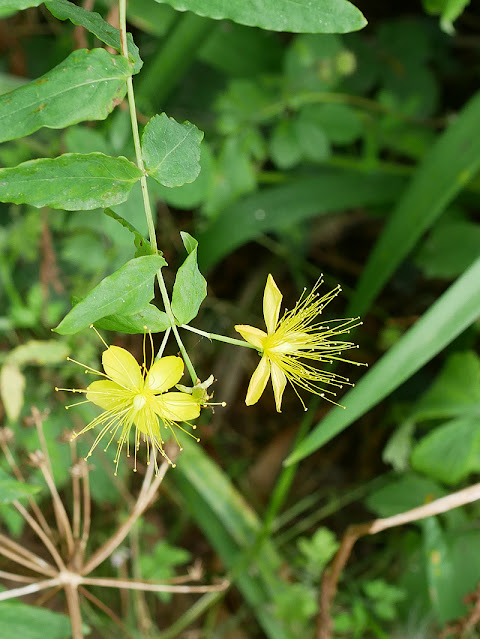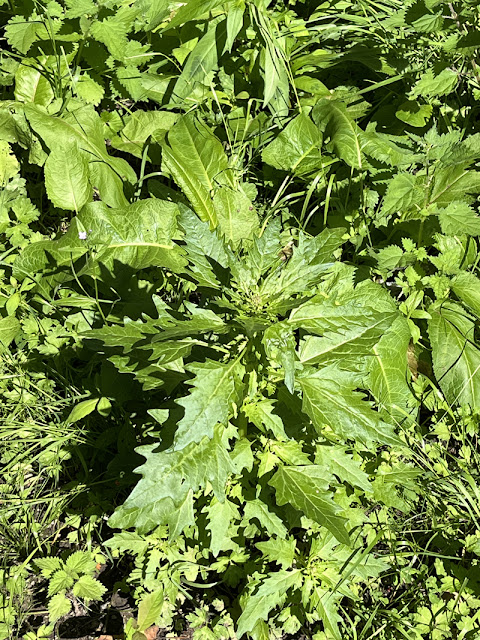The first group of plants come from a Cornwall Botany Group field trip to Loe Bar walking along coast, clifftop turf and arable fields to Gunwalloe not far from Helston.
Sea Beet isn't often photographed as it's a very common seaside plant related to garden Beetroot. However, they look quite exotic when the pods and fruits turn red, so they become worthy then of a portrait.
Beta vulgaris subsp maritima
We then found some that were fasciated, a condition I hadn't seen in this species before.
Almost onto the beach at Loe Bar was an all white variant of Betony, perhaps the salt influence affected its colouring?
Betonica officinalis
Some of the Cornwall Botany Group at Loe Bar which comprises of sparsely vegetated fine shingle.
A surprise find were a few ragged looking Chamomile on the coast path. They were ragged because walkers continually tread on them as they grew right in the middle of the path. A sniff of the crushed foliage easily identifies it from lookalike Mayweeds, it smells lovely!
Rock Samphire coming into flower, a sure sign of late Summer.
Crithmum maritimum
Common Dodder was prolific in some areas, almost all of it parasitising Common Gorse (Ulex europaeus). However, we did find one plant growing on Blackthorn (Prunus spinosa) which was a surprise.
Cuscuta epithymum
Due to declining habitats, Sea Holly is an uncommon plant, but it grew prolifically on Loe Bar. There were previous records too for Yellow-horned Poppies but we failed to find any which was a shame.
Eryngium maritimum
When in West Cornwall, it's always great to come across Cornish or Western Ramping Fumitory. It's the UK's largest flowered fumitory (the flowers are usually about 14mm long) and it is endemic to Cornwall, nearly all of it found West of the River Camel. Note the white border on the top petals, no other fumaria species has this, though they turn deep pink after pollination, as shown in the last photo.
Fumaria occidentalis
When I lived in Kent, I associated Ladies Bedstraw as a chalk plant, however, it grows in Cornwall anywhere where shell grit/sand is blown ashore as well as some road verges inland - much like Kent but without the chalk.
Galium verum
On CBG field trips there is usually an entomologist with us recording insects too. He found this 5cm long (excluding the antennae) Great Green Bush Cricket on an arable field edge for us to admire.
Tettigonia viridissima
Sea Sandwort with its pyramid like leaf structure is quite photogenic. They are in seed now and this photo shows the large seed pods which detach in time for the Autumn storm tides to float off and spread to other areas. The holes around it belong to solitary bee species burrowing into the harder sand of fixed dunes.
Honckenya peploides
A Frog Rush growing on old concrete on Gunwalloe beach.
Juncus ranarius
Below was a new species for me, though in seed now. Found by the VCR on a cliff, it is Crested Hair-grass.
Koeleria macrantha
We found a bunch of Cut-leaved Dead Nettles in an arable field with deeply incised teeth on the leaves.
Lamium hybridum
A Swinecress flowering on fine shingle.
Lepidium coronopus
Our entomologist kindly found a native Cockroach for us to admire. Up until then, I had no idea we had any cockroaches native to the UK. The one below is a flightless female Lesser Cockroach.
Ectobius panzeri
The rhino horned flower of Common Restharrow, the hairs on it being very glandular and smelling of gone off lemons. Rub some on you and it acts as an insect (and person) repellant too.
Ononis repens
A disused small quarry on the coast path had a lone Heath Pearlwort still in flower. Thanks to the occasional rain we've had throughout the Summer, some annual species have kept going all Summer long.
Sagina subulata
A Rock Sea-spurrey on a cliff. Their flowers are at least twice the size of the other spurries, so very easy to identify in flower.
Spergularia rupicola
Wild Thyme dotted the clifftop turf or on thin soil rock outcrops.
Thymus drucei
That summed up the field trip which was very enjoyable with good weather too. The next day I had an evening walk at Daymer Bay in the Camel estuary which is local to me.
A very late Pyramidal Orchid still just in flower in short turf.
Anacamptis pyramidalis
Carline Thistles, look dead but are actually in full flower.
Carlina vulgaris














































































